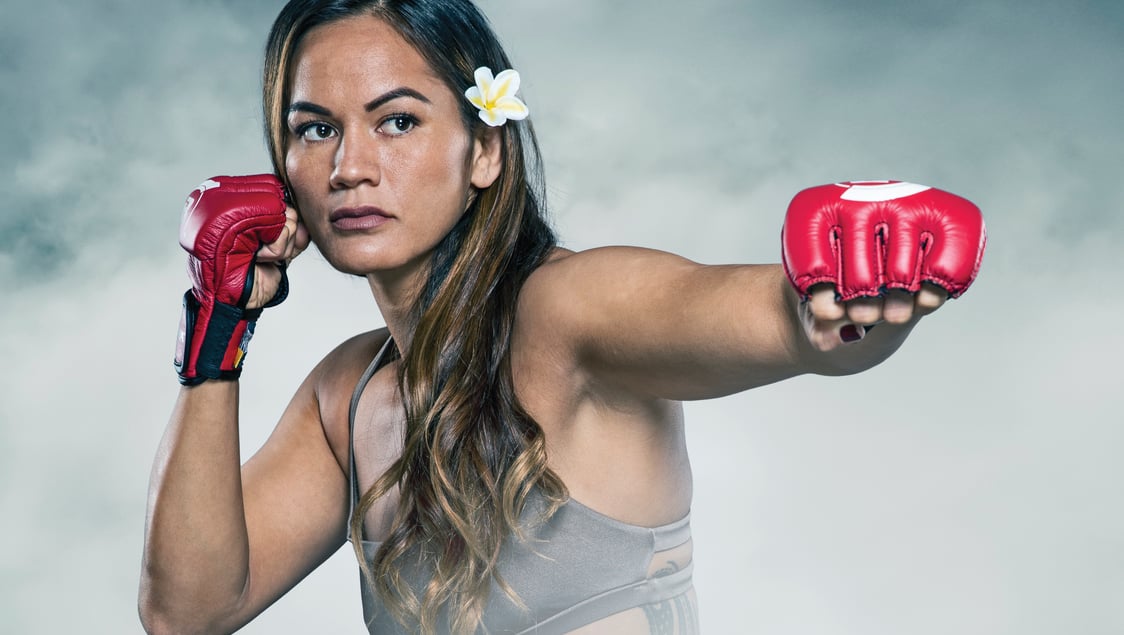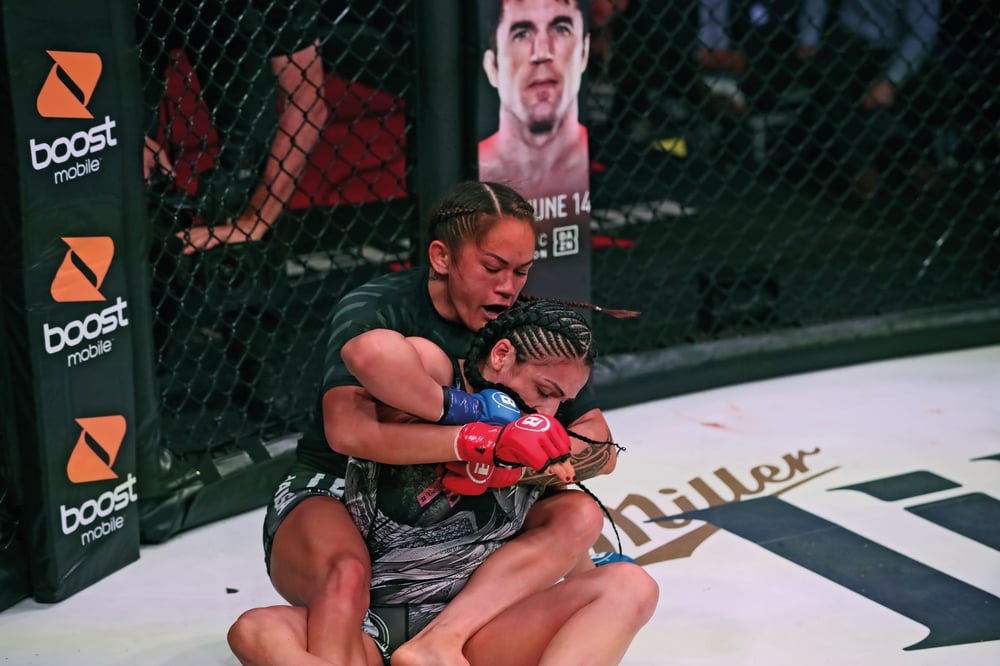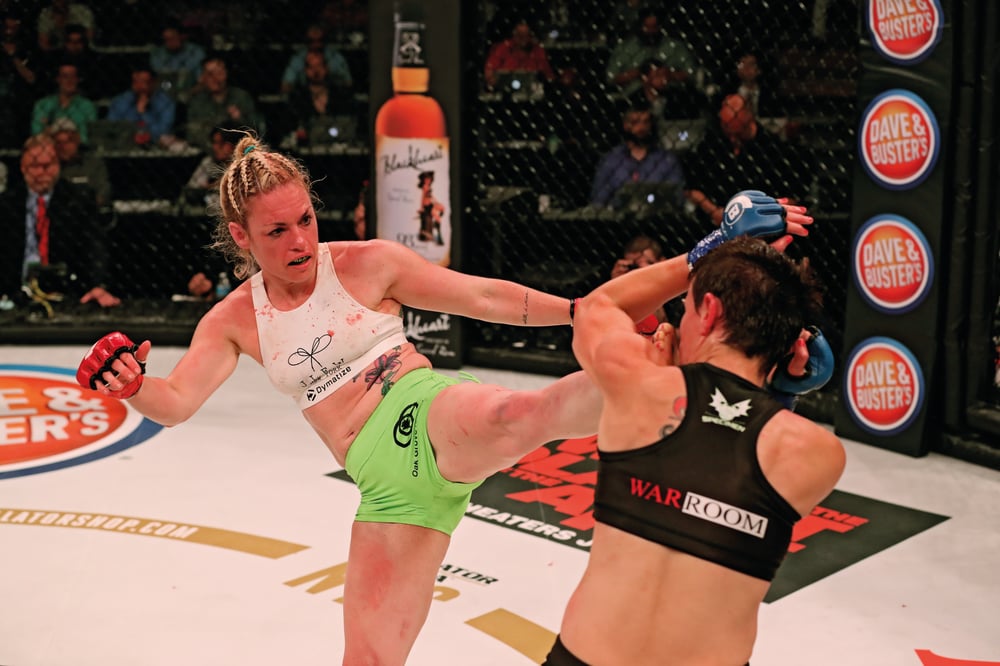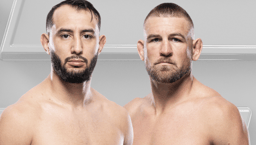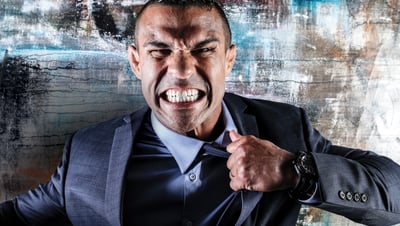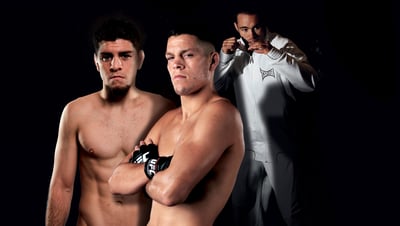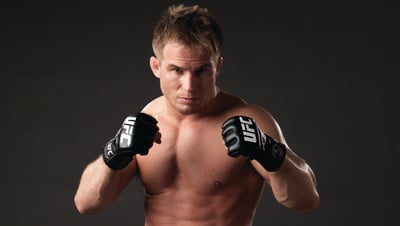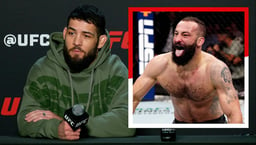
Issue 189
March 2020
From a marginal sideshow to the very heart of the mainstream, the growth of Women’s MMA has been the biggest story in the sport this past decade. Fighters Only looks back to its roots and forward to a bright future.
Sitting in a beaten-up Peugeot 205 in Bulgaria six years ago Ronda Rousey took a pause from filming The Expendables with Sylvester Stallone and Mel Gibson just outside Sofia and allowed your correspondent an intimate 45-minute interview in her second-hand motor to record a podcast. ‘Rowdy’ offered some words which I have never forgotten; nor indeed, the manner in which the uproarious blonde bombshell delivered them.
It was a powerful expression about women. Not just women in the fight industry, but women everywhere, in every walk of life. It was tantamount to a call to arms.
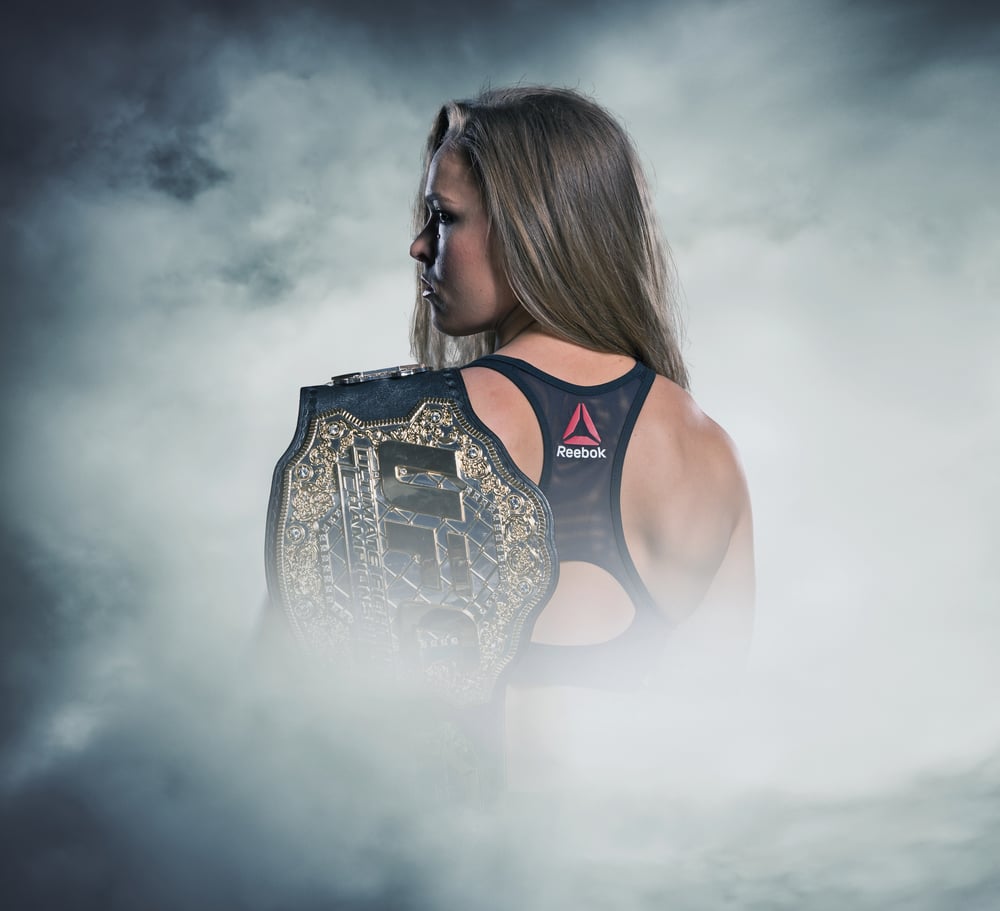
Rousey, of course, was in her pomp as a fighter right then, a pathfinder, a pioneer, a lightning rod for change. She told me, fake blood on her face (having just returned from filming a scene in which she was being whip-lashed in the movie by Gibson, in which she was hung in chains...): “We should be in every job. There should be women astronauts, women soldiers, women presidents, women surgeons and women fighters because why the fuck not? It should be like that everywhere.”
There were many women fighting before Rousey, but she was the one who shifted things, shifted attitudes in every class for every woman. Female editors at The Daily Telegraph – the upmarket newspaper for which I have written for almost 30 years – were contacting me, wanting to know who she was, why she wanted to fight so much, and what she was really like.
The fascination for this fighting woman knew no bounds. It was part of a revolution. A new era. It came from the whirlwind she brought with her from 2011 to 2015, which was also emotional and very, very real.
Love her, or hate her – and many did – Rousey meant business. But she created new business. Much of it for women. Made women pay-per-view-worthy. Rousey’s rise from Strikeforce and into the UFC, with her rivalries, ribaldry, her schisms with other female fighters, the comments from the likes of UFC president Dana White that she was the female version of what Mike Tyson had been in his heyday in heavyweight boxing, all helped to bring lasting change.
There is little doubt that the plethora of women, from the goofy to the glamorous, and the extraordinary stories we now follow with craning interest, owe much to Rousey’s force of nature that she brought unadulterated into the sport.
Regardless of what they say now, as her star fades in some minds, Rousey was a pathfinder. Single mothers, warrior princesses, pure fighters, transformative characters, our sport’s headlines now follow women as much as they do men... and it has mirrored society, perhaps more than in any other sport.
Pre-Rousey, the thought of women in the UFC was anathema to White, though the fight promoter Scott Coker had seen the value in Rousey, Miesha Tate and others in Strikeforce, and had, in the telling of history, put together the first women’s MMA superfight between Cris Cyborg Santos and Gina Carano in 2006. Coker knew they were two special fighters, special women, and that he had a moment in time on his hands and refused to see it pass without making it happen.
Indeed, having become the president of Bellator four years ago, both the UFC and Bellator are now replete with as many women as we might wish to see fight – as we do with their male counterparts.
Pound-for-pound, there is a strong argument that in storylines alone, the female fighters on every roster – from the electric athleticism of Angela Lee in Asia, to the emotional honesty that Cat Zingano brings in the west, for example – have as strong a resonance as any of the male fighters, from Jon Jones to Conor McGregor.
We love to watch men fighting, but women’s fighting has become just as fascinating, blending beauty and brutality, with a sense of peculiar voyeurism through simply watching the female of the species letting go with fists and feet in fury.
Women carry children, but they now also carry fight cards. And it has made the fight world a much better, much healthier place.
Gina Carano has become a film star after fighting, and recalled her superfight meeting with the Brazilian Cyborg all those years ago. “When I fought Cyborg my entire body was disconnected from my cognitive state,” she told me.
In the pantheon of MMA greats, Carano has her place, on a par with the likes of Chuck Liddell, Randy Couture and Tito Ortiz as one of the early pioneers at a time when the sport had a ‘wild west’ feel about it.
Carano combined looks, charisma and toughness. “We were the back alley fighters. There was an older school and I couldn’t take credit without recognizing there were many women that came before me and were much more hardcore than me. Angela Parr, I have to give a lot of credit to her,” explained Carano. “At the point I came into the sport, people (the fans) were really just starting to get interested (in women’s fighting).”
Fighting has a healing quality, is part therapy, part redemption, reckons Carano. As fighters, as she sees it, women and men are very similar. “I want to hurt myself. I think it’s just a fricking natural way of being. I believe it’s natural. We’re all fucking dark and evil. We’re all bad boys and bad girls and we’re all good boys and good girls.”
In other words, a fighter is a fighter, man or women, and some women are simply cut out for the struggle. It is simply in them, a means of expression.
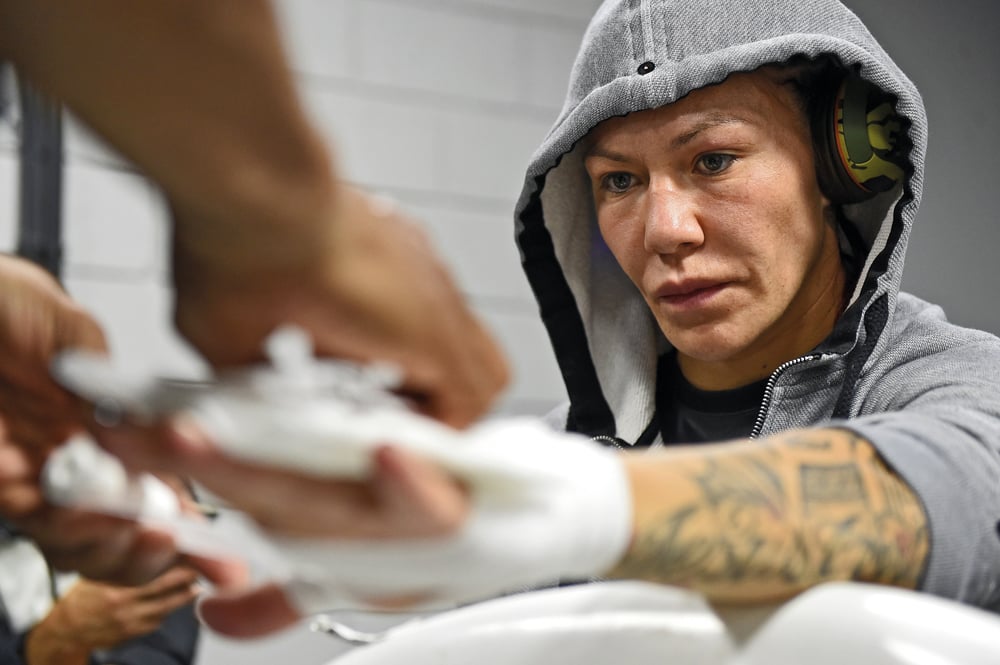
Carano’s old foe Cyborg has her own views on the development of women’s fighting. “At the beginning I couldn’t find any opponents, it was very difficult,” she explained. “I can look back and be thankful, like many other girls, with the development of women’s fighting in the sport It’s so cool. Girls can fight just as good as guys, we can be technical and we can be violent. It’s great to have the promoters who believes in us too.”
“Before, it was just guys fighting and guys would get together to watch the fight at the bar. Now it’s much more like a family. You have the wife, the husband and the kids and more. A lot of things had to change and a lot of things are getting better. Invicta opened a lot of doors for a lot of girls, it did for me. It’s has been part of the process.”
Indeed, it is remarkable how strong Invicta – the all-female fight league – has become, and how it has been a proving ground and a feeder league for the bigger fight organizations, led in tireless, fashion by Shannon Knapp.
Look across any fight league now and women spring out. The British UFC fighter Molly McCann has one of the most compelling personalities I have ever come across in fight sports. Her story, attitude and fortitude have all the ingredients of a blockbuster movie. She feels the sexual revolution in the sport.
“Women are at the forefront of a lot of sports because we’re doing better at many more of them than the men. All my mates are boys, I train with men,” she reasoned. “Women have been playing football for 20 years and look where we are. Men have been playing for 80 and look where they are. I believe in that time they’ve done amazing. It’ll only become more equal. I’m not for women getting a job over a man if they’re not qualified. It’s not about ticking a box. If you’re more qualified you deserve the job, if you’re not qualified you don’t. If it’s a panel full of men or a panel full of women, it is what it is. I don’t want to be scared to talk and be frank. It’s like the whole LGBT pride month. People jump on it to make money when they aren’t actually that supportive.”
The flyweight fighter had started out more involved in football. “I was so tiny. I got knocked off the ball. I’d skin anyone with a step over. I’d slide tackle and kill ya. I’d play the ball into feet and if I got it 30 yards out my first thought was to try go for it. My style of playing football, I’d always give more than anyone else. I feel it’s still the same with fighting. My will to win is greater than anyone else. The only time I’ve lost really is when I made a mistake.”
There are reasons why she can fight. “I had a rough upbringing. There was a lot of substance abuse growing up. It wasn’t stable. I just remember being a kid upstairs in my room and hearing parties and arguments. Parties going on for days and random people coming in and out of the house. I was always moving around. I’d come down the stairs and see bottles and all sorts of different substances. I remember looking at my mum and dad and my heart would hurt. I got looked after by my biological nan. My biological dad couldn’t get himself right, but my mum did. My mum is 23 years clean. She’s the director of a drug rehabilitation charity. She’s a strong woman. Whenever I’m fighting she always tells me I’m going to win. I ask why and she says it’s because I’m made from her, cut from her cloth. I know I can do anything because of what she’s done.”
“I’ve had this conversation quite a few times the past few months. My reason for fighting has changed. Before it was all about ego, pride and being the hardest twat in the room. I don’t want this to come across in the wrong way...but I genuinely believe that I have to perform now, be as great as I can be now so I can do even more when I’m finished fighting, because I want to be out there, speaking and inspiring people, the next generation.”
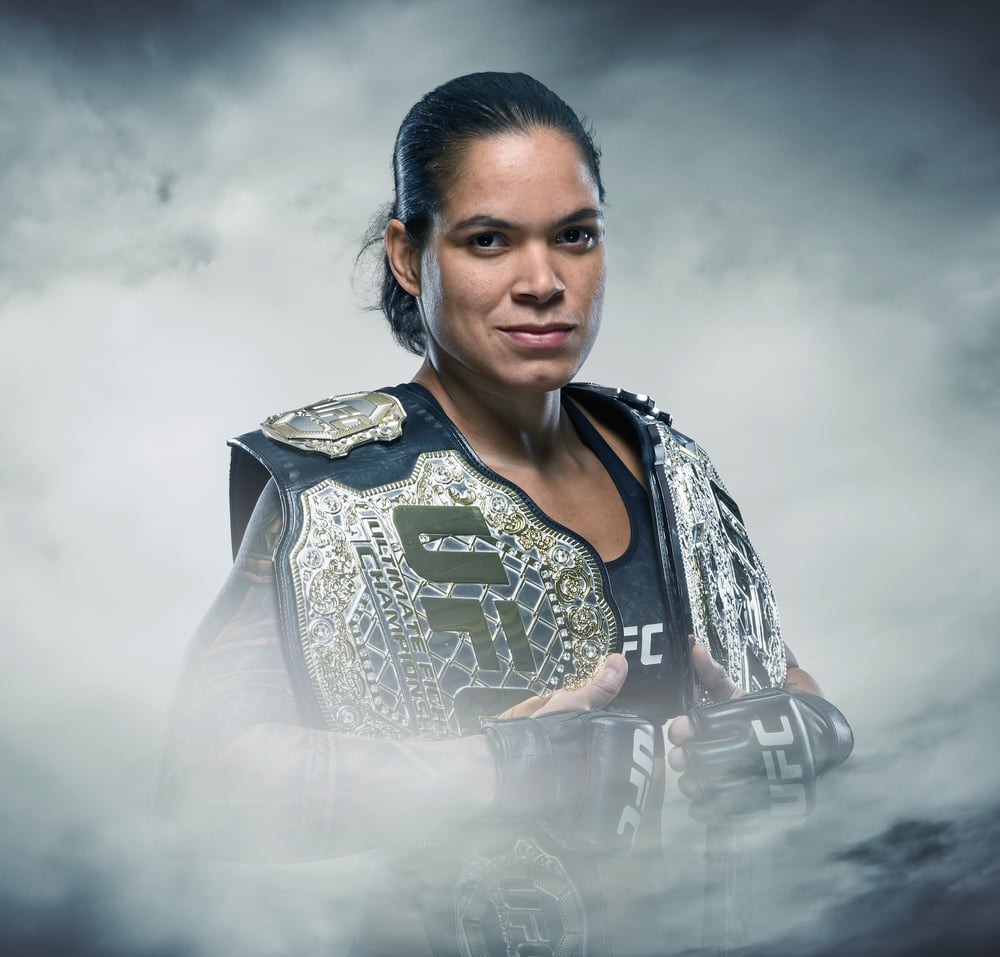
Amanda Nunes is another who is inspiring many into the sport. She has a life partner in fellow fighter Nina Ansaroff. “I’ve still got a lot of people to help me and who look up to me. My journey is only beginning and I want to keep making history. I haven’t done this by myself. I’ve done it with my teammates, my corner, my family, my fans and the media. I try to put on a show every time I step in the cage. I feel like the fans like to see that. They want a fighter to try. Because of that they’ll start believing in us.”
That sense of being a pioneer also envelops Holly Holm. There were times when ‘The Preacher’s Daughter’ was underestimated. “That’s been a lot of my career, but it’s also what’s kept me driven. It makes me stronger. If a situation requires more struggle and is more of a challenge, I remember I’m here for a reason. My dad told me a lot of people think ‘why me?’ instead of ‘why not me?’ You might as well go for what you want. Why don’t I go out there and go for it.”
Bellator featherweight Julia Budd is another strong character who draws a deep respect, has power in her bearing, and in her fighting prowess. “Women’s fighting has reached a new level,” she told me. “Yeah, definitely. The publicity and fan base grows, it gains momentum every year and it’s exciting. Scott Coker has always believed in the female athletes. I think Bellator has two incredible divisions and I couldn’t be more proud when I went on to become the champion of the 145lb division.”
She had fights in school, but is dismayed looking back on it. “Girls can be jerks. I think at the time it was a miscommunication. Something to do with the boyfriends of one of the girls, nothing to do with me, but I somehow got dragged into it by my older sister. Next thing you know she’s showing up at my work and is all, ‘Tomorrow, at the Shell Station, I’ll be there after school and we’re going to fight’. I remember freaking out, but I showed up. I don’t even know if there were punches thrown or if it was a bunch of hair pulling. I started martial arts and it shot me down a totally different path. I’m pretty sure the whole high school was there watching, it was awful.”
“I think we were two scrappy girls that wouldn’t back down. It started a reputation for me as the tough girl, but I didn’t fight again after that. Me and the girl talked about it years later and laughed about it. It was the first fight I ever got into.”
“I was a total tomboy growing up, all my best friends through elementary school were guys. I played soccer. In a small community, I played in the guy’s league. I was always really athletic, but because it was such a small community, when you got to a certain age they want girls to play with girls. Softball, soccer – you get put into women’s leagues. It wasn’t feeding my competitive drive. It was perfect timing, because I quit all the sports I was playing when I found kickboxing. Once I got a taste of kickboxing, I fell in love with it.”
One of the advantages for women, Budd feels, is the opportunity in many places to spar with men. “I still think there are gyms out there that are not female-friendly, but there are so many out there now. All my training partners are guys. They’re awesome. I’ve learned so much from them. That’s how I got my nickname in 2005, I was the only girl on the team. I think it’s a big reason I’ve got as far as I have. I’m always comparing myself to males.”
Ilima-Lei Macfarlane is a new kind of pioneer and has single-handedly brought the Bellator fight league to Hawaii twice, the venue having been fallow and ignored for a decade. She has recently involved herself in campaigning for women’s rights, and has used her platform to campaign in political movements in her homeland.
“The political climate here in Hawaii is a little bit tense at the moment for native Hawaiians,” she explained. “There’s a situation on Mauna Kea that I’m involved with. I’ve flown back and forth from the big islands since the construction of the 30 meter telescope has started. This walk out was dedicated to all the protectors. They’re still up there. I just wanted to use all women. I have my scholarship for young native girls. It’s very important for me to represent them. I had these women, a lot of them were family members. I thought last year was emotional but backstage I really lost it. That was really special for me. It was very powerful. It was all I could imagine. They asked me before they went out if I wanted to come up with them. It was the first time doing that dance with them. I hope people understood our message.
“It’s so cool to be included with all the names who have done so much for MMA,” she continued. “But it’s also a cool feeling that I’m a girl, a little girl who brought MMA back to Hawaii.”
As Coker explained of his flyweight champion: “Ilima-Lei has a bigger purpose. We all respect her. We provide the platform. If that’s her message, that’s what it is. She’s a very special person and athlete. We’re proud to have her as our champ.”
Mixed Martial Arts has long been a popular sport for many reasons but one of the major growing attractions is that the UFC, and Bellator have men’s and women’s bouts on the same bill. And there have been many instances when the women’s fights have stolen the show. Not surprising, looking at the talent pool around the sport.
There is the new wave – Rose ‘Thug’ Namajunas, established herself as one of the fiercest fighters the UFC has ever seen. Her victory over Joanna Jedrzejczyk as a huge underdog saw her become a star, and her openness about her life has made her even more popular. Then others, like skilled practitioner Valentina Shevchenko, or the vicious Polish fighter Jedrzejczyk herself, all of whom have their own unique brands, and a pulling power with fans.

In the UFC, China has recently seen its first female champion in Weili Zhang, and in Bellator, the likes of Alejandra Lara, from Colombia, have brought a new dimension having been an athlete and acrobat. Victory in Hawaii last year over Veta Arteaga, saw her finish with the splits in the cage. It was one of the pictures of the year.
Heather Hardy is another who has a story of her own. “I think you have to show little girls what they can become. You can’t be what you can’t see,” she explained. “They can be a boxer or a martial artist and a mother, a divorced woman, a female who likes to dress well and show off.”
Hardy crossed to mixed martial arts from being a boxing world champion. “My message is you can be all these things. One of them or ten of them. It doesn’t matter. Be the best you, you can be,” said Hardy, a single mother in her thirties.
Hardy went public a few years ago about being the victim of sexual assault as a teenager. She was in with the wrong crowd at the time. It appears to have been empowering to tell her story under the umbrella of fight sports. To hear Hardy speak, is to understand why fight sports have a deeper place in our society than we often care to believe.
Born and raised in South Brooklyn, in Gerritsen Beach, a working-class community of around 5,000, and sporting Celtic tattoos, the former women’s boxing and kick-boxing world champion, turned her focus to martial arts because it was hard to make a living. The world of MMA, she feels, treats women with more equality than boxing has for many years. Hardy is a ferocious fighter; attack is her defence. And it does not always pay off. She wins some, she loses some. But she is certainly consistent. As indeed she feels about MMA, and her treatment by Bellator MMA.
“MMA is consistent and boxing isn’t,” she told me. “In boxing, you have to wait on other promoters’ schedules. I went six months trying to get a unification fight that fell through at the last minute. Boxing can be a disappointing sport when you have so many conflicting forces in charge, trying to make things happen. I’m 37 years old, I don’t have time to be waiting on other people’s schedules. In MMA there is plenty of room to grow. I love the pureness of MMA.”
Bellator flyweight champion Macfarlane speaks of her admiration for Hardy. “I love Heather and I’ve always been a big fan of hers. I even compare her to Jen Brown. She’s our sportscaster on Paramount, a mother of two toddlers, loving life and is a career woman – she does it all. I admire her and women like Heather Hardy that are all these different roles, doing what they want to do. They are breaking boundaries and not fitting the mold of what is expected. You don’t have to be special, it should just be the norm. We can do all of these roles.”
“There’s not a lot of women fighters, because what we do is very special and unique. I do feel like we are special or cut from a different cloth. In ten years time I’ll be 39. I’ll be at my 20th high school reunion. I hope to be a mother by then. Being successful, whether I’m single or happily married doesn’t really matter, I’d just like to be a mother. I’m actually going to freeze my eggs next year. As a birthday present to myself on my 30th. I feel I could be a single mother, I’ve done everything else by myself. I think if I had two kids, I need a partner for that. I won’t be fighting in ten years, hell no. I hope to be a home owner, have a child and own my business. And be commentating for Bellator. That’s my ten-year plan. Politics might be an option as well. They don’t have any Hawaiian women in Congress. We’ll see.”
Hardy takes up the powerful theme of women fighting. “We’re not just females, we’re athletes. We’re just like the guys. We deserve the same money, the same recognition.”
I asked Hardy, deep down, why she fights. “Because I’m good at it.” Perhaps there is no better reason than that. As society evolves, so does women’s professional fighting, emblematic of this time of growth. One thing is for sure – women’s MMA is growing and growing, and is here to stay. Amen to that.
...
